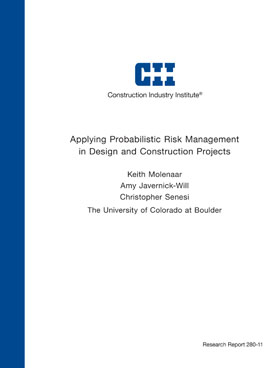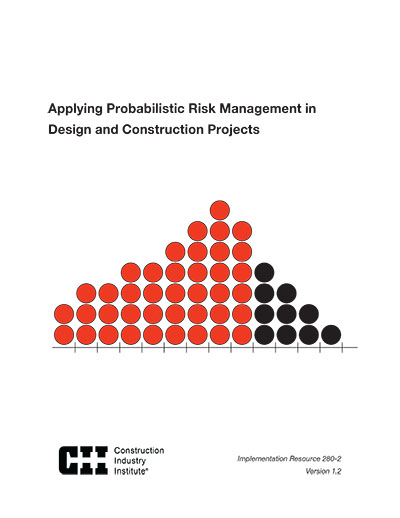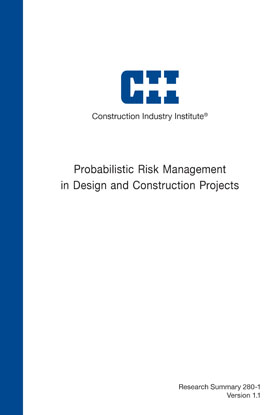
Applying Probabilistic Risk Management in Design and Construction Projects
The design and construction of capital projects can be extremely complex. Uncertainty and risk add to this complexity and, as a result, many projects experience significant cost overruns and schedule delays. In order to better understand a project’s risk profile, including the confidence in meeting cost or schedule projections, estimating a reasonable contingency, and prioritizing the mitigation of risks with the greatest impact on the project, organizations are beginning to implement probabilistic risk management. The use of probabilistic risk management approaches enables decision makers and project stakeholders to have a better understanding of project drivers, increased certainty in project based decisions, and improved ability to successfully achieve desired outcomes.
While tools for identifying, assessing, and managing risk and uncertainty for capital projects are neither new nor unique to the industry; the vast majority of the construction industry employs only deterministic approaches to risk management. Deterministic approaches have clear benefits but they stop short in the ability to understand the inherent uncertainty that exists in the planning and execution of capital projects. Adding probabilistic risk management approaches to the standard suite of risk management tools allows project teams to understand, manage and mitigate the potential project risks explicitly.
Research Team 280 used a multi-method research approach to determine the benefits and barriers of applying a probabilistic approach to analyze cost estimating and schedule risks for the design and construction of capital projects. The team administered two survey questionnaires and conducted in-depth case studies of twelve multi-national owner and contractor organizations. The analysis of the responses, interviews, practices, processes and applications of probabilistic risk analysis enabled the team to determine: what risk management processes organizations are employing; a process for how organizations can implement more advanced risk management approaches; an identification of why organizations are employing probabilistic risk management; and why others are not. This allowed the research team to document the common benefits and barriers of employing probabilistic approaches to risk management and to identify a common process for organizations wishing to use more advanced risk management approaches on their projects.
This research report documents the benefits that organizations employing probabilistic risk management approaches receive, including: increased internal collaboration and discussion; the ability to better manage risks; project costs and schedules; and increased confidence in project decision making. It also notes the barriers organizations experience when implementing probabilistic risk management. These barriers include: the initial lack of technical expertise; the difficulty in interpreting results from the probabilistic analysis; the lack of support from management within the organization; and the lack of policies and procedures that support the use of probabilistic risk management approaches.
In addition to identifying the benefits and barriers, the research identified a common process organizations followed to implement probabilistic risk management approaches. This path includes three tiers, starting with risk identification, proceeding to the use of deterministic risk analysis, and finally advancing to the use ofprobabilistic risk analysis. RT 280 developed a one-page summary that explains the outputs, benefits, requirements and limitations of each of these tiers in Implementation Resource (IR) 280-3, What’s the Risk). In addition, the team developed risk registers for each tier along with guidance on how to use the risk registers in IR 280-2. An example project is analyzed with this tool in IR 280-1. Finally, in order to address one of the barriers, interpreting the results from probabilistic analysis, the back-side of IR 280-3 contains the interpretation of common outputs of probabilistic analysis that help aid decision-makers on projects.
RT 280 recognizes that not all projects require the use of probabilistic risk management approaches. As a result, the research identified project attributes that trigger the organization to employ probabilistic risk management approaches on their projects. Although triggers were not employed consistently across all organizations, common triggers included project cost, a delivery method that entailed the acceptance of increased risk, and the novelty or “newness” of a project (location, project type, project stakeholders, etc.).
Together, these results help to answer the essential question, “What would be the benefits and implications of applying a probabilistic approach of analyzing cost estimating and scheduling risks for design and construction of capital projects.” They help an organization better understand the benefits and requirements of using probabilistic approaches for projects and, given the slow adoption of these methods in the design and construction industry, provide guidance for a process that can be used to implement more advanced risk management approaches. When employed, these probabilistic methods will help the project team and organization better manage project risk and uncertainty in cost, scope and schedule.



